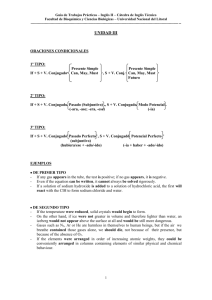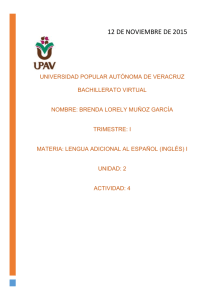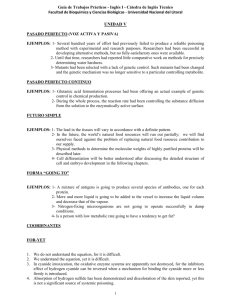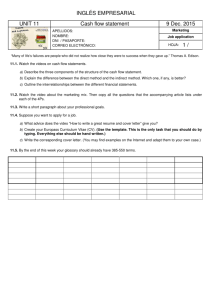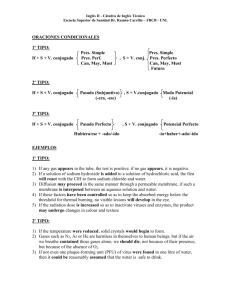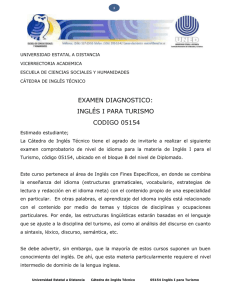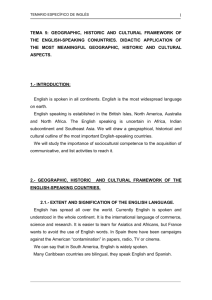a) Complete el siguiente párrafo utilizando la Tabla
advertisement
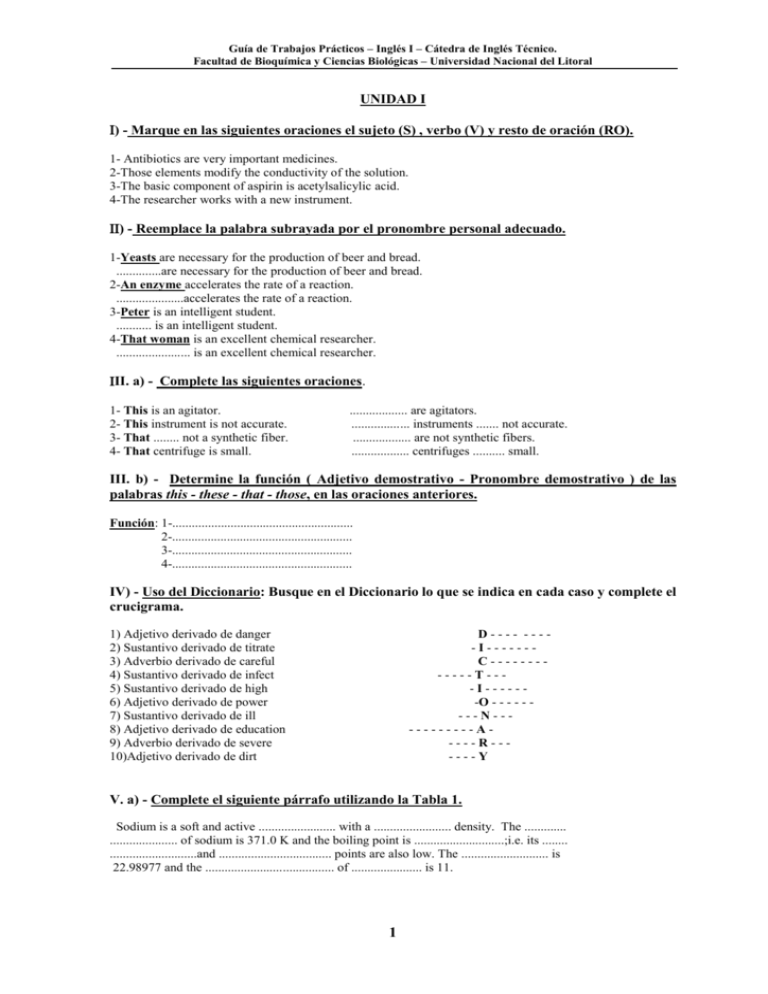
Guía de Trabajos Prácticos – Inglés I – Cátedra de Inglés Técnico. Facultad de Bioquímica y Ciencias Biológicas – Universidad Nacional del Litoral UNIDAD I ) - Marque en las siguientes oraciones el sujeto (S) , verbo (V) y resto de oración (RO). 1- Antibiotics are very important medicines. 2-Those elements modify the conductivity of the solution. 3-The basic component of aspirin is acetylsalicylic acid. 4-The researcher works with a new instrument. ) - Reemplace la palabra subrayada por el pronombre personal adecuado. 1-Yeasts are necessary for the production of beer and bread. ..............are necessary for the production of beer and bread. 2-An enzyme accelerates the rate of a reaction. .....................accelerates the rate of a reaction. 3-Peter is an intelligent student. ........... is an intelligent student. 4-That woman is an excellent chemical researcher. ....................... is an excellent chemical researcher. II. a) - Complete las siguientes oraciones. 1- This is an agitator. 2- This instrument is not accurate. 3- That ........ not a synthetic fiber. 4- That centrifuge is small. .................. are agitators. .................. instruments ....... not accurate. .................. are not synthetic fibers. .................. centrifuges .......... small. III. b) - Determine la función ( Adjetivo demostrativo - Pronombre demostrativo ) de las palabras this - these - that - those, en las oraciones anteriores. Función: 1-........................................................ 2-........................................................ 3-........................................................ 4-........................................................ IV) - Uso del Diccionario: Busque en el Diccionario lo que se indica en cada caso y complete el crucigrama. 1) Adjetivo derivado de danger 2) Sustantivo derivado de titrate 3) Adverbio derivado de careful 4) Sustantivo derivado de infect 5) Sustantivo derivado de high 6) Adjetivo derivado de power 7) Sustantivo derivado de ill 8) Adjetivo derivado de education 9) Adverbio derivado de severe 10)Adjetivo derivado de dirt D---- ----I------C------------T---I------O - - - - - ---N-----------A----R------Y V. a) - Complete el siguiente párrafo utilizando la Tabla 1. Sodium is a soft and active ........................ with a ........................ density. The ............. ..................... of sodium is 371.0 K and the boiling point is ............................;i.e. its ........ ...........................and ................................... points are also low. The ........................... is 22.98977 and the ........................................ of ...................... is 11. 1 Guía de Trabajos Prácticos – Inglés I – Cátedra de Inglés Técnico. Facultad de Bioquímica y Ciencias Biológicas – Universidad Nacional del Litoral Class Texture Colour Density Atomic weight Melting point Boiling point Atomic number metal Soft silver low ( 0.97 ) 22.98977 low (371.0 K) low (1156 K) 11 Table.1: PROPERTIES OF SODIUM: ( Na+ ) V. b) - PERIODIC TABLE Coloque el número asignado a cada una de las propiedades del sodio en el lugar que le corresponde en la tabla periódica. 11 22.98977 1 1156 Na 371.0 Ne3s1 0.97 Sodium 1- Melting point 2- Atomic weight 3- Chemical symbol 4- Atomic number 5- Electronic configuration 6- Density 7- Boiling point 8- Oxidation state 9- Chemical element VI) - En la columna de la derecha se mencionan una serie de enfermedades autoinmunes y en la de la izquierda los correspondientes órganos afectados. Una cada enfermedad con el órgano que corresponda. ORGAN Liver Thyroid gland Muscle Skin Joints Blood (platelets) Blood (red cells) Testis (spermatozoa) Pancreas (insuline- producing cells) DISEASE Anemia Diabetes Rheumatoid Arthritis Cirrhosis Male Infertility Pemphigus (blisters) Myastenia Gravis (muscle weakness) Underactive or Overactive Thyroid Bruising and Bleeding 2 Guía de Trabajos Prácticos – Inglés I – Cátedra de Inglés Técnico. Facultad de Bioquímica y Ciencias Biológicas – Universidad Nacional del Litoral VII) - Traduzca los siguientes grupos de palabras. 1) low-temperature reaction 2) heat-sensitive instruments 3) ultra-high speed 4) world-wide scale 5) non-resistant material 6) ready-to-use device 7) by-products 8) finger-like projections Observe cómo distintos tipos de palabras se combinan para formar frases modificadoras de sustantivos. VIII) - NUTRITION. VIII.a) - De acuerdo a los datos de la tabla, diga a qué alimento o vitamina se refiere cada enunciado: Beef Milk Eggs Wheat (germ) Citrus fruits Halibut liver oil 1) 2) 3) 4) 5) Thiamin (mg/100g) 0.05-0.1 0.04-0.06 0.1-0.15 2.5-5.6 Vit. C (mg/100g) Trace Trace Vit. A (g/100g) 10-20 20-50 200-400 Vit. D (per 100g) Trace Trace-0.2 ug 4-10 g(yolk) 1,000,0002,000,000 0.5-10 mg 25-60 significant quantities of Vitamin C only significant amounts in eggs and halibut liver oil a particularly high concentration of Vitamin D a negligible quantity of Vitamin D and small but significant amount of Vitamin A present in significant amounts in eggs and particularly in wheat germ VIII. b) - Seleccione la alternativa correcta para los valores que figuran más abajo, de acuerdo a los datos de esta tabla: Nutrient Protein Vitamin A Vitamin E Vitamin C Thiamin Iron Copper Test* Total protein (S) g/100ml Vitamin A (P) ug/100ml Tocopherols (P) mg/100ml Ascorbate (B) mg/100ml Pyruvate (B) mg/100ml Iron (S) ug/100ml Copper (S) ug/100ml Level suggesting deficiency 6.0 10.0 0.4 0.3 1.0 50 75 * P, plasma; S, serum; B, whole blood * a deficiency of copper 68 g/100ml (S) * an adequate amount of copper * a sufficient quantity of Vitamin A 19 g/100ml (P) * a lack of Vitamin A * adequate Vitamin E level 0.25 mg tocopherol per 100 ml * inadequate Vitamin E level * enough iron in the body iron level between 55 and 75 g/100ml (S) * a shortage of iron 3 Usual range 6.5-8.6 20-49 0.6-1.5 0.4-1.0 0.3-0.9 60-160 81-147 Guía de Trabajos Prácticos – Inglés I – Cátedra de Inglés Técnico. Facultad de Bioquímica y Ciencias Biológicas – Universidad Nacional del Litoral * adequate thiamin level concentration of pyruvate in the blood above 1mg/100ml (B) * not enough thiamin IX) - Arme oraciones y tradúzcalas. 1) 2) 3) are – human – substances – chemical – in – body – the – there – lots of – complex. production – country – vitamins – the – a – is – of – priority – this – in – synthetic. (oración interrogativa) bottle – gas – this – pressure – at – in – the – atmospheric – not – is. 1)........................................................................................................................... ..................................... ................................................................................................................................. ................................... 2)................................................................................................................................................................. .................................................................................................................................................................... 3)................................................................................................................................................. ............... .................................................................................................................................................................... X) - Traduzca el siguiente texto. Figure.1: Densimeter. This is a densimeter. It is necessary to assess the density of a substance. What is the density of a substance? It is the weight of the unit volume of that substance. The measurement of the density is a measurement of the weight and the volume of certain mass of the substance. The quotient of the weight and volume is equal to the Density. =W/V XI) - Traduzca el texto. The internal structure of an animal cell is very complex. The nucleus is at the center of the cell. It contains the genetic material. A membranous envelope, the nuclear membrane, surrounds the nucleus. This membrane has pores. In the cytoplasm we find different organelles: the synthesis of new proteins occurs in the ribosomes. These new proteins move to the Golgi complex. They undergo a process of maturation with the incorporation of residues of sugar, etc. Other organelles, the mitochondria, produce the necessary energy to maintain the cellular functions. Lysosomes are organelles with enzymes. They destroy strange substances. The plasmatic membrane covers the cell. It maintains the normal internal environment and the shape of the cell. XII) - A partir de la siguiente tabla, elabore oraciones y tradúzcalas is There are two much some few little lots of several many undesirable impurities metabolic changes hydrogen atoms oil elements volatile components copper extinguishers 4 in this sample. in this molecule. in drinkable water. in that mixture. near the lab. in this disease. in the Periodic Table. within the flask. Guía de Trabajos Prácticos – Inglés I – Cátedra de Inglés Técnico. Facultad de Bioquímica y Ciencias Biológicas – Universidad Nacional del Litoral 1)…………………………………………………………………………………………. 2)…………………………………………………………………………………………. 3)…………………………………………………………………………………………. 4)…………………………………………………………………………………………. 5)…………………………………………………………………………………………. 6)…………………………………………………………………………………………. 7)…………………………………………………………………………………………. 8)…………………………………………………………………………………………. XIII) - Luego de leer y analizar el siguiente texto resuelva la ejercitación que está a continuación. Every 28 days one of the ovaries releases an ovum and this passes through the reproductive system. The development of the ovum, its release (ovulation) and subsequent events occur in a cyclical process controlled by hormones. This is called the menstrual cycle. Menstrual cycle hormones have different functions: the oestrogen causes onset and maintenance of secondary sexual characteristics, e.g. breast development, fat accumulation, and so on. Furthermore, it repairs the uterus wall after menstruation and increases thickness of the uterine wall. Progesterone prepares uterine wall for implantation and inhibits oxytocin. This oxytocin stimulates uterine muscular contraction during labour and the secretion of milk. These hormones are secreted by the pituitary gland, ovaries and corpus luteum. XIV. a) - ¿Verdadero o Falso? 1- Oxytocin regulates the menstrual cycle. 2- Oestrogen maintains the human secondary sexual characteristics. 3- Ovulation is controlled by hormones. 4- Hormone concentration changes in pregnancy. 5- Every 28 days each ovary releases an ovum. XIV. b) -Identifique claramente a qué se refieren (o sea, a quién reemplazan) las siguientes palabras: “this” (primer renglón del texto) ............................................ “its” (línea 2) .......................................................................... “this” (línea 3) ........................................................................ “it” (línea 5) ........................................................................... XV. a) Lea el siguiente texto y ubique en él las siguientes palabras: in, on, within, with, of, near, close, without, to (pueden repetirse) The endocrine glands. The endocrine glands produce important chemical substances: the hormones. They regulate many chemical processes ---------- the body. The pituitary gland controls the other endocrine glands. ----------- it, a young animal does not grow or develop sexually. ---------- humans, the pituitary is only 2 cm --------- diameter. The thyroid gland produces thyrotoxine, a complex chemical --------- iodine. When the diet does not contain enough iodine, the gland does not produce sufficient thyroxine. On the other hand, when thyroxine production is excessive, there is an increase --------- the rate of metabolism, the animal burns food and it loses weight. 2 Guía de Trabajos Prácticos – Inglés I – Cátedra de Inglés Técnico. Facultad de Bioquímica y Ciencias Biológicas – Universidad Nacional del Litoral The adrenal glands are ------- the kidneys. They produce adrenaline and several other hormones. Adrenaline provides extra energy ---------- the muscles --------- time --------- danger. The pancreas is -------- to the duodenum. It produces insulin and this assists --------- the regulation --------sugar --------- the body. When there is an excess or deficiency --------- insulin, the amount --------- sugar ----the blood increases, and a disease (diabetes) results. XV. b) Ponga las frases que siguen en el orden en que aparecen en el texto anterior a) the function of insulin b) the result of iodine deficiency c) the effects of removal of the pituitary gland d) the process leading to loss of body weight e) the function of hormones f) the function of the endocrine glands g) the cause of diabetes h) the function of the pituitary gland i) the location of the pancreas j) the function of adrenaline k) the size of the pituitary gland XV. c) - Ahora diga si las siguientes oraciones son verdaderas o falsas. a) b) c) d) e) f) g) h) The shape of the pituitary gland is roughly spherical. Removal of the pituitary gland results in excessive growth. The thyroid gland serves to produce insulin Most diets contain a small amount of iodine; consequently, production of thyroxine takes place. When insufficient thyroxine is produced, an animal loses weight. When an animal is in danger, the production of adrenaline increases. The gland responsible for the production of insuline is near the duodenum. Lack of insulin results in high levels of sugar in blood and diabetes. XVI) - Lea el siguiente texto y con los datos que allí figuran, realice un esquema. THE STRUCTURE OF PLANT CELLS. The outer layer of a plant cell is called the cell wall. This is composed of a lifeless material: cellulose. The inner surface of the cell wall is lined with a layer of protoplasm. The nucleus is embedded in this layer. Part of this protoplasm surrounds the nucleus and is called cytoplasm. The cytoplasm sometimes contains chloroplasts. These are small bodies and are composed of protein. The surface of the cytoplasm is covered with a cell membrane. The centre of a plant cell consists of a cavity: the vacuole. It is filled with fluid. The walls of a plant cell are often joined to other cells around it. The layer between the walls of two cells is called the middle lamella. XVII) - Determine qué partes del aparato digestivo describen estas oraciones. 1) Bile is produced in this organ. 2) Digested food is absorbed into the blood stream through its walls. 3) Bile is conduced to the duodenum through it. 4) Food is chewed and mixed with saliva in this part. 5) The bile is store here. 6) An alkaline fluid is secreted by this gland and passes into the duodenum. 7) The undigested waste (faeces) is rejected through this sphincter. 8) Not much digested food is absorbed here but the walls serve to absorb the liquid content of undigested food. 9) The walls are lined with muscles. They serve to churn the food and mix it with gastric juice. 10) The passage of food from the stomach is controlled by this valve. 3 Guía de Trabajos Prácticos – Inglés I – Cátedra de Inglés Técnico. Facultad de Bioquímica y Ciencias Biológicas – Universidad Nacional del Litoral The human digestive system and digestive processes. 4 Guía de Trabajos Prácticos – Inglés I – Cátedra de Inglés Técnico. Facultad de Bioquímica y Ciencias Biológicas – Universidad Nacional del Litoral XVIII) -Estudie cuidadosamente este diagrama y complete las oraciones que están a continuación del mismo. a) The chlorophyll is stored in the .................................... and enables ................................. to grow. b) Water enters the cells as a result of the action of .............................. c) CO2 enters the cells as a result of absorption from the ................................ and diffusion from the ................................. d) The action of photosynthesis leads to the production of .................................. e) Enzymes act on ............................ to produce .................................. f) The chemical action of photosynthesis also results in the release of ......................... g) Photosynthesis occurs when the leaf is exposed to .................................... and ............... is present in the air. 5 Guía de Trabajos Prácticos – Inglés I – Cátedra de Inglés Técnico. Facultad de Bioquímica y Ciencias Biológicas – Universidad Nacional del Litoral XIX) – a) Lea el siguiente texto Immunology is the study of how a complex system of cells (the immune system) fights and kills foreign (1) substances or antigens. The main cells in the immune system are the lymphocytes. Lymphocytes are white blood cells which produce antibodies (these protein molecules neutralize the antigen). The shape of the antibody molecule axactly matches (2) the shape of the antigen. The antibody sticks (3) tightly to the antigen and forms an antigen-antibody complex. Another important cell in the immune system is the phagocyte (this word means “a cell that swallows (4) ”. Phagocytes swallow dead cells and antigen-antibody complexes and then destroy them. Another important type of immune cell is the killer cell. It kills foreing cells after antibodies have stuck to them. Phagocytes then swallow the dead cells. b) Con la ayuda del diagrama siguiente proponga un significado para las palabras marcadas en negrita. XX) - Lea con detenimiento las siguientes oraciones y luego inserte los grupos de palabras que le damos () donde le parezca que corresponde. Observe el uso del participio pasado (formas “-ado”, “-ido”) como adjetivo. 1) ---------------------------------- in the basal medium is measured with an oxygen analyzer. 2) The ----------------------------- in the graph indicates the theoretical molecular diffusion. 3) After the treatment, the -------------------------------- of mammalian embryos regroup rapidly. 4)The ---------------------------------- of volume fractions of a liquid at various temperatures are provided inTable I. 5) ----------------------------------- of each strain are retained as controls, and all the cultures are subcultivated in the usual way. 6) The new vaccine is made from an --------------------------------. 7) In this process, --------------------------------- are stored in liquid nitrogen. () dispersed cells estimated densities broken line inactivated virus frozen cells 6 dissolved oxygen unmixed cultures Guía de Trabajos Prácticos – Inglés I – Cátedra de Inglés Técnico. Facultad de Bioquímica y Ciencias Biológicas – Universidad Nacional del Litoral XXI) - Estas son algunas formas de expresar en Inglés las ideas de frecuencia, probabilidad, tendencia. Lea y observe los esquemas que acompañan al texto. Ahora diga cuál de las siguientes expresiones le parece más apropiada para cada ejemplo: all - many - no - some - nearly all - most - few. Luego reemplácela con el adverbio de frecuencia correspondiente, según el esquema anterior. a) Plants possess chlorophyll. b) Mammals have tails c) Bacteria are harmless. d) Birds fly e) Plants need light. f) Microbes reproduce sexually. g) Living organisms need oxygen. h) Fungi have chlorophyll i) Plants live under water. j) Plants have cell walls of cellulose. k) Green plants gain their energy from the sun. l) Insects possess wings 7 Guía de Trabajos Prácticos – Inglés I – Cátedra de Inglés Técnico. Facultad de Bioquímica y Ciencias Biológicas – Universidad Nacional del Litoral XXII) - NUCLEOPROTEIN METABOLISM. Nucleo proteins are conjugated proteins. When a nucleoprotein is eaten, enzymes in the intestine hydrolize it into protein and nuclein. This is further hydrolyzed into protein and nucleic acid and the proteins are further hydrolyzed by the proteolytic enzymes of the intestine to aminoacids. The nucleic acid is first hydrolyzed by the enzyme phosphatase to form nucleotides. At the same time phosphoric acid is removed from each nucleotide. Finally, the resultant nucleosides are split into sugar and purine or pyrimidine by the enzyme nucleosidase. Con información proveniente del texto complete el diagrama que sigue. Nucleoprotein Protein Nucleic acid Purine................. Pyrimidine ................... Amino acids Purine nucleosides Pyrimidine nucleosides Purine XXIII) - Lea atentamente el texto que sigue y resuelva la ejercitación. ANOXIA. The term anoxia literally means without oxygen and it is commonly used to indicate shortage of oxygen. However, it is preferable to refer to a condition of too little oxygen as hypoxia. There are four commonly defined causes for lack of sufficient oxygen for the cells of the body and they are now stated in the commonly used terms. Anoxic anoxia, or hypoxic hypoxia refers to decreased oxygen saturation of blood hemoglobin because of insufficient oxygen in the alveolar air. It is associated with low tension of oxygen in the arterial blood. This condition is produced by obstructions of lung passages or inadequate oxygen supply. The second type of anoxia is anaemic anoxia. This occurs in individuals with a too low hemoglobin content to carry the required amount of oxygen. The oxygen tension is normal but there is a shortage of oxygen due to the lack of hemoglobin. The third type of anoxia is stagnant anoxia. This is due to a too slow blood flow round the circulation. The oxygen tension and content are normal in the lungs, but the supplies of fresh oxygen are delivered too slowly to provide the tissues with sufficient oxygen. The fourth type of anoxia is histotoxic anoxia. An example of this is cyanide poisoning. The cyanide destroys the enzyme system of the cells and prevents the utilisation of the oxygen present in the blood. a) - En sus palabras: - ¿Qué significa anoxia? - ¿Cuántos tipos de anoxia se definen en el texto? 8 Guía de Trabajos Prácticos – Inglés I – Cátedra de Inglés Técnico. Facultad de Bioquímica y Ciencias Biológicas – Universidad Nacional del Litoral b) - Complete la siguiente Tabla: Tipos de anoxia Causa c) - Diga si los siguientes enunciados son verdaderos o falsos. 1) El término hipoxia describe mejor un estado donde hay poco oxígeno que el término anoxia. 2) En la “anaemic anoxia” el problema es la tensión de oxígeno, que es baja. 3) En la “anoxic anoxia” no llega suficiente oxígeno a los alvéolos. 4) Ciertos venenos bloquean los sistemas enzimáticos en el cuarto tipo de anoxia. XXIV) - En el siguiente texto, ponga los verbos en Presente Simple, respetando la forma y Voz (activa o pasiva) que correspondan en cada caso y tradúzcalos. With a few possible exceptions, the protoplasm (organize)....................................... in cells. The cell (be) ................... the unit of life and it (consist)......................... of a mass of protoplasm; it (surround)...................... by a plasma membrane and (contain)...................... a central mass -the nucleus. This nucleus (surround)......................... by a membrane. When organisms (classify)............................, the minimal, simple condition (represent).............................. by the single-cell organisms. As their name (state)........................, they (consist) ........................of only one cell. But all organisms (consist)......................., at the very beginning of their life cycle, of a single cell -the fertilized egg. This egg, afterwards, (give rise)........................................, by a series of successive divisions, to all the cells in their bodies. The egg cell (divide) .............................into two to form two cells. Then, each of these cells (divide).................... into two again and thus (give).................... a total of four cells. This process (repeat)...................... until the organism (acquire).................................. its final structure. 9
